
Polystichum munitum, the western swordfern, is an evergreen perennial fern native to western North America, where it is one of the most abundant ferns in forested areas. It occurs along the Pacific coast from southeastern Alaska to southern California, and also inland east to southeastern British Columbia, northern Idaho and western Montana, with disjunctive populations in northern British Columbia, Canada; the Black Hills in South Dakota, United States; and Guadalupe Island off of Baja California, Mexico. Western swordfern is known to have locally naturalized in parts of Great Britain and Ireland.

Fremontodendron californicum, with the common names California flannelbush, California fremontia, and flannel bush, is a flowering shrub native to diverse habitats in southwestern North America.

Fern Canyon is a canyon in the Prairie Creek Redwoods State Park in Humboldt County, California, western United States. The park is managed in cooperation with other nearby redwoods state parks and Redwood National Park. It is named for the ferns growing on the 50-foot (15 m) high walls, through which runs Home Creek. Fern Canyon is recognized as a World Heritage Site and an International Biosphere Reserve.
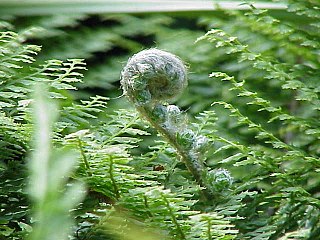
Polystichum is a genus of ferns in the family Dryopteridaceae, subfamily Dryopteridoideae, according to the Pteridophyte Phylogeny Group classification of 2016. The genus has about 500 species and has a cosmopolitan distribution. The highest diversity is in eastern Asia, with about 208 species in China alone; the region from Mexico to Brazil has at least 100 additional species; Africa, North America, and Europe have much lower diversity. Polystichum species are terrestrial or rock-dwelling ferns of warm-temperate and montane-tropical regions. They are often found in disturbed habitats such as road cuts, talus slopes, and stream banks.
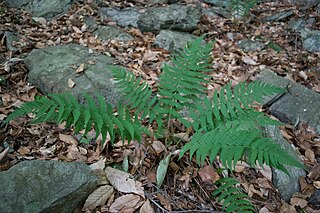
Dryopteris marginalis, vernacularly known as the marginal shield fern or marginal wood fern, is a perennial species of fern found in damp shady areas throughout eastern North America, from Texas to Minnesota and Newfoundland. It favors moderately acid to circumneutral soils in cooler areas but is fairly drought-resistant once established. In the warmer parts of its range, it is most likely to be found on north-facing non-calcareous rock faces. It is common in many altitudes throughout its range, from high ledges to rocky slopes and stream banks. Marginal wood fern's name derives from the fact that the sori are located on the margins, or edges of the leaflets.

Polystichum acrostichoides, commonly denominated Christmas fern, is a perennial, evergreen fern native to eastern North America, from Nova Scotia west to Minnesota and south to Florida and eastern Texas. It is one of the most common ferns in eastern North America, being found in moist and shady habitats in woodlands, stream banks and rocky slopes. The common name derives from the evergreen fronds, which are often still green at Christmas.

Polypodium calirhiza is a species of fern in the polypody family. Its common names include nested polypody and habit polypody. It is found in California and Oregon in the U.S., and several states of Mexico: Colima, Jalisco, Mexico State, Oaxaca, and Veracruz. The leaflets on each leaf are broad and oval-shaped, coming to a dull point. This fern is sometimes epiphytic.
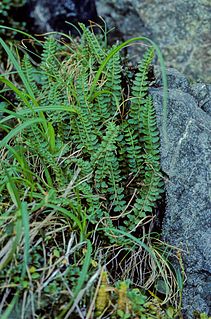
Polystichum aleuticum, the Aleutian holly fern or Aleutian shield fern, is an endangered species of the Polystichum genus and currently consisting of a small, vulnerable population endemic found only on Adak Island, Alaska, a remote island of the Aleutian Islands chain in the northern Pacific Ocean. In 1992, 112 specimens existed in the wild, and a recovery plan was implemented.

Ophioglossum californicum, known by the common name California adder's tongue, is an uncommon species of fern in the family Ophioglossaceae.
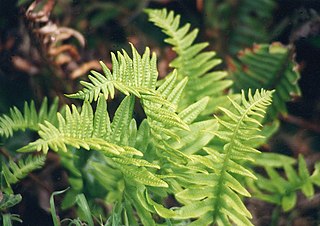
Polypodium californicum is a species of fern known by the common name California polypody.

Polystichum dudleyi is a species of fern known by the common name Dudley's sword fern. It is endemic to California, where it is known from the forests of the central and southern California Coast Ranges.
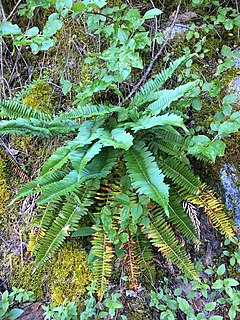
Polystichum imbricans is a species of fern known by the common names narrowleaf swordfern and imbricate sword fern. It is native to western North America from British Columbia to southern California, where it grows in rocky habitat in coastal and inland mountain ranges and foothills. This fern produces several erect linear or lance-shaped leaves up to 80 centimeters long. Each leaf is made up of many narrow, overlapping, sometimes twisting leaflets each 2 to 4 centimeters long. The leaflets have toothed edges. This fern readily forms hybrids, some of which are fertile and are considered separate species, such as Polystichum californicum, its hybrid with P. dudleyi.

Polystichum lemmonii is a species of fern known by the common names Lemmon's holly fern and Shasta fern. It is native to western North America from the Sierra Nevada of California north to Washington. It is also known from British Columbia, where there is a single occurrence in the mountains above the Okanagan Valley.

Polystichum lonchitis is a species of fern known by the common name northern hollyfern, or simply holly-fern. It is native to much of the Northern Hemisphere from Eurasia to Alaska to Greenland and south into mountainous central North America. It has stiff, glossy green, erect fronds and grows in moist, shady, rocky mountain habitats.
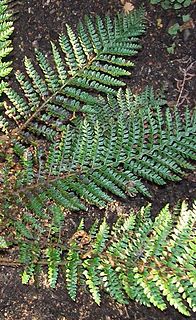
Polystichum proliferum, commonly known as mother shield fern is an Australian endemic fern. The genus name Polystichum is derived from Greek poly - many, and stichos - rows referring to the many rows of sori. The species name is derived from Latin, Proli – offspring and fer - bearing referring to the proliferous buds, a prominent feature of the species.
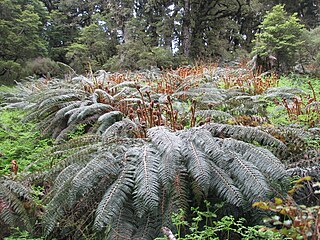
Polystichum vestitum, commonly known as the prickly shield fern or pūnui (Maori), is a hardy, evergreen or semi-evergreen ground fern.

Polystichum tsus-simense, commonly known as the Korean rock fern, is a perennial herbaceous plant native to East Asia. Its common name corresponds with its ability to grow in shady areas of rock walls. This fern species is a familiar ornamental plant grown in home gardens.

Asplenium gracillimum is a fern species native to Australia and New Zealand, also found in Stewart Island and the Chatham Islands. The specific epithet gracillimum refers to the slender and graceful appearance of this fern.


















